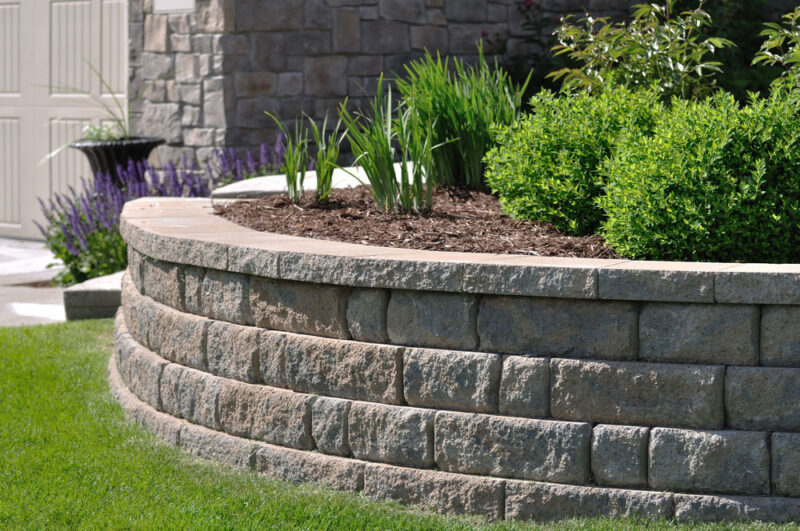While walls are often thought of as design elements, they can be useful for landscaping as well. Landscaping walls can be freestanding, serve as a garden backdrop, or used to create a private area. Landscaping walls can also be used to retain soil after an excavation project. In this particular case, they’re called “retaining walls.”
Retaining walls can be used to hold up sections of your yard and can be made of wood, masonry, poured concrete, or concrete blocks. While they do have a practical purpose, they can also give your yard design more aesthetic appeal. Building a retaining wall can be a DIY job, but it’s also hard work. It’s important to get the construction done properly. Otherwise, you’ll be making unnecessary repairs later on.

Benefits of a Retaining Wall
Some of the benefits of a retaining wall can include the following:
- Reduced Runoff — Retaining walls can reduce the amount of runoff on your sloped lawns, which can cause all kinds of problems for your yard (including pooling water and soil movement). A retaining wall minimizes this problem by interrupting the steep slope of the yard.
- Improved Value — Having a retaining wall on your property can make it more appealing to potential buyers, so it can increase the value of your home. Even if you’re not thinking about selling the property anytime soon, it never hurts to invest in certain improvements.
- Aesthetic Appeal — A sloped backyard doesn’t have a lot of aesthetic appeal, and you can’t do a lot of planting if the yard is too steep. Installing a retaining wall will turn your backyard into a more attractive space, because you’ll have an area that’s better for landscaping.
- More Square Footage — Retaining walls can create a level space in an area of your yard that would otherwise have a natural slope. This will give you more square footage to work with, so your yard can have more space for landscaping and sitting areas (including patios and terraces).
- Erosion Prevention — A steep yard can create an ideal environment for erosion, because it will have more water runoff. This can cause erosion to happen more quickly, as soil from the top runs down with it.
Be sure to speak to a professional for more information.
Common Causes of Retaining Wall Problems
Retaining walls have to work a lot harder than freestanding walls. Aside from having to support their own weight, they also have to be resistant to the lateral forces caused by soil retention. This soil can get saturated with water, which can create a tremendous amount of force (especially with the slow-draining and expansive clay soil we have in the Coastal Bend). Special provisions have to be made when building a retaining wall, which will include the following:
- A batter (or pitch) is created, so it leans toward the soil it’s retaining.
- Tie-backs (which are also called “dead-man anchors”) are installed to tie the wall inside the soil located behind the wall.
- Drains are laid behind the foot of the wall, so water can be moved away before pressure can build up and push against the wall.
- Footings (which are beds of compacted gravel) are used to support the wall, especially if the soil is loose or is prone to freezing.
If the retaining wall has no batter, a problem with the anchors, drains that have become clogged, or a base that isn’t firm enough, a retaining wall can start to settle, tilt, or buckle. Tree roots can also add to the pressure. Even the weight of items placed on the ground above and behind the walls (such as parked vehicles or outbuildings) can add to the strain.
Options for Retaining Wall Repair
Whether it’s made of stone, block, concrete, or wood, a retaining wall can lean. When this happens, you have two choices. You can demolish the entire wall and re-excavate before reinstalling the drainage system and rebuilding the wall. But if you want a more cost-effective solution, you can have the wall repaired by calling a foundation repair expert. This person will be able to stabilize the wall. In many cases, it can be pulled back to its original position.
Foundation repair companies can fix foundation walls by using similar techniques, and one method that has gained widespread acceptance is the use of helical anchors. These helix-shaped blades are welded onto steel shafts, which forms an anchor that looks like a giant screw. Holes are cut into the wall, which are used to accommodate the blade’s diameter. Then, hydraulic rotary equipment is used to drive it into the wall and deep into the soil.
Retaining Wall Repair FAQ
Retaining walls are important for many homes, especially in areas with creative landscaping and hardscaping designs for aesthetic and functional purposes. These walls are more than decorative features. They create support for soil retention, protect against erosion, and even create level spaces for gardens, patios, or other outdoor living spaces. But like any other part of a landscape design, retaining walls will require regular maintenance and the occasional repair to keep their integrity and beauty.
Here are some common questions people ask about retaining wall repair.
Regular maintenance will not only extend the life of your retaining wall but will also help you avoid more expensive repairs. Even if there are no visible issues, scheduling annual inspections can help you catch potential problems early on (which can save you both time and money).
There is no “one size fits all” approach for retaining wall maintenance. Whether it’s made of stone, brick, or concrete, each wall will require more tailored care to make sure it lasts a long time. It’s important to do seasonal maintenance checks, because detecting problems early will keep minor issues from becoming major problems.
It’s also important to implement a good cleaning strategy, because it will make it look better and can prevent damage from dirt and moisture. A mild cleaning agent and a low-pressure washer can remove grime without damaging the wall. But if you want to get more thorough results, you should think about hiring a professional cleaning service that uses more specialized techniques.
One of the most important parts of retaining wall maintenance is making sure it has enough drainage. Otherwise, water buildup can lead to hydrostatic pressure (which can cause them to bulge or fail). French drains or weep holes can provide enough drainage, which can relieve pressure and extend the wall’s life.
Cracks can often be caused by soil pressure, water buildup, or the aging of the wall materials. If you address drainage issues and inspect your retaining wall for wear, you can prevent and repair cracks more effectively.
If your retaining wall is tilting, bulging, or has large cracks, it may be time to contact a professional. Ignoring any of these signs can result in more involved (and more expensive) repairs later on.
While minor maintenance and cleaning tasks can be done yourself, structural repairs usually require a professional landscaper to ensure safety and longevity.
Some of the visible signs that your retaining wall needs to be repaired include the following:
Cracks — The appearance of cracks on a retaining wall can vary in size. Smaller cracks may be the result of natural settling, but larger ones can be a sign of a more serious structural issue. The wall may be having a hard time holding back the soil because of pressure, material failure, or flaws in the construction.
Bulging — This is often caused by poor drainage and usually suggests that the wall can’t manage the water and soil it’s meant to retain.
Leaning — If your retaining wall is leaning away from the soil it supports, it’s a sign of imminent failure. It can be caused by an inadequate foundation, soil erosion, or the weight of the soil itself (especially if it’s saturated with water).
Be sure to speak to a professional for more information.
Retaining wall issues can build up slowly over a long period of time, but a true catastrophe is often sudden. When your wall can no longer “retain,” property damage, personal injury, and even death can occur. Don’t make the mistake of ignoring the early warning signs of a retaining wall that needs to be fixed. Some of them can include the following:
Tilting and pulling.
Rotting (if the wall is made of wood).
Crumbling (if the wall is made of concrete).
Soil separation.
Water pooling around the base.
All of them are strong indications that your retaining wall needs to be repaired.
If you’re looking for one of the best places for foundation repair in Corpus Christi, be sure to get in touch with Streem Foundation Repair.
